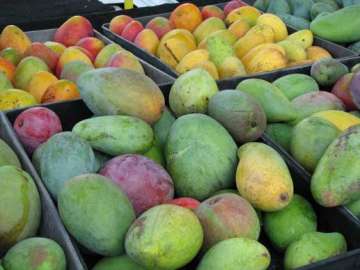Mangoes of India: Gadha is fodder for donkeys, Haramzada bland in taste and Langda not lame
The Gadha is fodder for donkeys, the Haramzada good looking but bland in taste and the Langda, well, not lame but a little off balance
The Gadha is fodder for donkeys, the Haramzada good looking but bland in taste and the Langda, well, not lame but a little off balance.
Mangoes all, but each distinctive in taste, look and etymology! And there are some 297 more varieties growing in the Noor Bagh orchard in Rataul, the town that gives name to its own species of mango and is about 50 km from New Delhi.
In a country where spirited debates over which mango is better can go on for hours - and even take on regional overtones - mangoes could well be the food for argument.
Enter Noor Bagh -- created a century ago by Maulvi Hakimuddin and now owned by his great-grandson Zahoor Siddiqui -- and the mango horizon suddenly broadens.
Rataul once had 500 varieties of mango and is now a repository of 300, says cultural historian Sohail Hashmi.
Though the Rataul is a local favourite, Hashmi expands our aam dictionary beyond the usual Dussehri, Chausa and Langda by telling tales of other varieties.
The list is long -- the Makhsoos (the chosen one), Khas- ul-Khas (choicest among the chosen), Samar-e-Behisht (fruit of heaven), Zardalu (yellow potato) and Ghulab Khas (special rose) among others.
Explaining the etymology, origin and juiciest tales behind many of these, Hashmi, who curates mango walks, warns everyone to beware of the Haramzada (bastard).
"It is called Haramzada because though having all the good looks of a well ripened mango, it is bland in taste," he chortled.
Then, there's the much loved Langda, which will be the first one to fall even if the wind is blowing 10 miles away.
"Iska balance bigda hua hai (It's off balance).
Hence the name Langda," he said and the laughter followed.
The region is also home to the Tamuriya mango, named after Taimur, the 15th century military ruler and founder of the Timurid Empire, who is believed to have passed through on his way to invade Delhi.
This mango commemorates the passage of Taimur, Hashmi said.
There is a mango called Dudhia Baghalpuri, dudhia because it is almost white, and Baghalpuri because the sapling was from Bhagalpur in Bihar.
The mango, Hashmi said, also smells of raw rice.
But, how do you differentiate between one mango tree and another? "In every mango tree, the leaves are different.
So even if the tree is not bearing any fruit, an expert can tell you about it just by seeing the leaves," answered Hashmi.
Hashmi has long been chasing the Karela, which looks like the bitter gourd and has a similar after taste too.
"I have found two such trees of Karela aam in Bhopal, and will soon get a sapling to Rataul," he said.
There is also the Fazri or Fazli, the last mango of the season that can grow up to 1 kg and is sometimes called the Gadha aam.
"This mango is fodder to donkeys.
Though edible, it is mostly used to make mango chutney.
If only they grew earlier in the season, they could replace the Safeda, used for mango shakes," Hashmi said, feasting on a deep orange Anfas.
Historian Rana Safvi, a fellow walker on the mango tour, says the great Indian mango fetish has been here since the time of the Mughals.
"When Babur came here, he complained of having no fruits worth eating.
Later on, it was Jehangir who said that had his grandfather tasted mangoes he would have changed his opinion," Salvi said.
According to Rana, much of the Indian obsession with mangoes can be blamed on Ghalib, who romanticized this fruit just a bit too much when he said "only donkeys don't eat mangoes".
Siddique, who now owns Noor Bagh, runs the Salma Public School, a primary school for underprivileged girls.
The entire proceedings from the mango walk were donated to this school.
